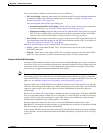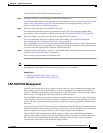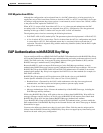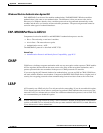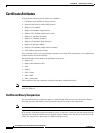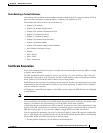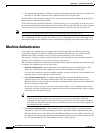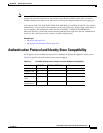
B-28
User Guide for Cisco Secure Access Control System 5.3
OL-24201-01
Appendix B Authentication in ACS 5.3
EAP-FAST
This scheme improves the security by reducing the amount of cryptographic sensitive material that is
transmitted.
This section contains the following topics:
• Key Distribution Algorithm, page B-28
• EAP-FAST PAC-Opaque Packing and Unpacking, page B-28
• Revocation Method, page B-28
• PAC Migration from ACS 4.x, page B-29
Key Distribution Algorithm
The common seed-key is a relatively large and a completely random buffer that is generated by the
primary ACS server. The seed-key is generated only once during installation, or it can be manually
regenerated by an administrator. The seed-key should rarely be replaced, because if you change
seed-key, of all the previous master-keys and PACs would automatically be deactivated.
The seed-key is generated by using a FIPS approved RNG generator that exists in the runtime
cryptographic module (CryptoLib). The ACS primary server management determines when to generate
the seed-key, and communicates with the ACS runtime to request a new seed-key to be generated.
The size of the seed-key may vary and should consist of at least 64 bytes (512 bit). A larger seed might
have some performance implication as each master-key derivation is dependant on it subsequently.
At any given time, a single seed-key should be used by each ACS server and the primary ACS server
should ensure to distribute the latest seed-key to all the servers. Old seed-keys must discarded.
The seed-key contains critical cryptographic sensitive information. Disclosing the seed-key information
would expose the entire EAP-FAST PAC mechanism to a large set of possible identity vulnerabilities.
Because of that, the mechanism which transports the seed-key between the primary and the secondary
ACS servers must be fully secured. Further security measures must be taken with respect to storing the
seed-key in the data-base. The seed-key should be protected with the strongest means of security.
EAP-FAST PAC-Opaque Packing and Unpacking
When the server generates a new PAC, it must derive the master-key to be used. When the server accepts
a new PAC the same algorithm should be used for deriving the master-key with some additional
verification used to prevent possible attacks on the master-key scheme. The derivation calculation may
be skipped if the master-key was already placed in the cache in the past.
Revocation Method
You can revoke all PACs and all Master-Keys. For this type of extensive revocation, all you need to do
is to revoke the seed-key and replace it by a new one.
Having only a single seed-key to be used in the system facilitates implementation.






